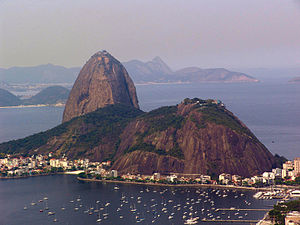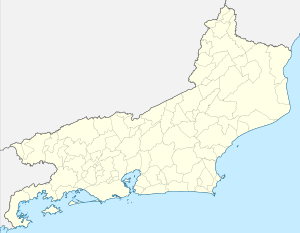Sugar loaf (rocks)
| Sugar Loaf | ||
|---|---|---|
|
View of the Sugar Loaf and the Morro da Urca |
||
| height | 396 m | |
| location | Rio de Janeiro , Brazil | |
| Dominance | 5.05 km → Corcovado | |
| Notch height | 376 m | |
| Coordinates | 22 ° 56 '58 " S , 43 ° 9' 23" W | |
|
|
||
| rock | granite | |
| First ascent | 1817 by Henrietta Carstairs | |
| Development | O Bondinho ( aerial cableway ) | |
|
View from Guanabara Bay |
||
The Sugar Loaf , Portuguese Pão de Açúcar ("carrot"), is a 396 meter high, steep-walled rock on the Urca peninsula at the western entrance to Guanabara Bay in Rio de Janeiro , Brazil . It belongs to the hill group of the same name, Pão de Açúcar , which consists of the Morro da Urca and the Morro da Babilônia .
The Sugar Loaf consists of shell-like, weathered, coarse gneiss-like granite and is the remains of an intrusion .
Along with the Corcovado with its Christ statue Cristo Redentor, it is considered the landmark of Rio de Janeiro.
history
Origin of the name
The name of the rock reflects the great importance of sugar cane for Rio de Janeiro . Portuguese sailors settled in Brazil in the 16th and 17th centuries. They formed the cane sugar into blocks for transport and shipped it to Europe. These so-called carrots were reminiscent of the shape of the sugar loaf, from which it got its Portuguese name.
In German it bears his name because its shape is reminiscent of a sugar loaf .
First ascent and development
The Sugar Loaf, which was previously considered un-climbed, was climbed for the first time in 1817 by the English mountaineer Henrietta Carstairs . In 1972 the steep side of the Sugar Loaf was first climbed by a German-Austrian rope team .
The O Bondinho cable car , the sides of which are fully glazed, leads up to the Sugar Loaf . On October 27, 1912, the first section on the Morro da Urca was completed; A year later, the second section followed, which leads to the summit of the Sugar Loaf. At the summit, next to the cable car station, there are several viewing platforms as well as a souvenir shop and a small bamboo forest, which is criss-crossed by walking paths.
Location and surroundings
To the north of the Sugar Loaf is Guanabara Bay with the immediately adjacent district of Botafogo and the government district of Flamengo . To the south and west are the Praia Vermelha and Copacabana beaches , which can be seen from the summit of the Sugar Loaf. The beaches of Ipanema , Leblon and Barra da Tijuca to the west are not visible from the Sugar Loaf.
geology
The Sugar Loaf consists of gneiss-like granites that rose into the earth's crust as plutons about 560 million years ago during the Pan-African Orogeny . The dome-shaped shape of the rock, which was already created by the formation, was further strengthened by desquamation , as the outer layers of the rock separated from the rest of the mountain like onion peel.
The rocks of the Sugar Loaf are clearly related to rock deposits from the Western Congo Belt , Kaoko Belt , Damara Belt , Gariep Belt and Saldania Belt , which lie on the other side of the South Atlantic . Before the opening of the Atlantic, these geological units, now separated by the ocean, were adjacent.
Web links
- Old postcards from Sugar Loaf (Portuguese and English)
Individual evidence
- ↑ Pão de Açúcar on Peakbagger.com (English)
- ↑ a b c Torsten Purle: Stone Witnesses - Sugar Loaf from Rio de Janeiro. In: steine-und-minerale.de. acquimedia, April 4, 2018, accessed April 28, 2019 .
- ↑ KKJ: The Sugar Loaf of Rio de Janeiro. In: erlebnis-rio-de-janeiro.de. Blog Experience Rio de Janeiro, Robert Schwab, August 13, 2014, accessed on April 28, 2019 .
- ↑ Rio de Janeiro - the city on the carrot? In: lr-online.de. Lausitzer Rundschau , June 13, 2014, accessed on April 28, 2019 .
- ↑ a b David Klaubert: Rio de Janeiro: The happy man from the Sugar Loaf. In: faz.net. Frankfurter Allgemeine Zeitung, January 16, 2013, accessed on February 24, 2015 .
- ↑ Luiz Carlos Da Silva, Neal J. Mcnaughton, Léo Afraneo Hartmann & Ian R. Fletcher: Zircon U-Pb Shrimp Dating of the Serra Dos Órgãos and Rio De Janeiro Gneissic Granitic Suites: Implications for the (560 Ma) Brasiliano / Pan- African collage . In: Revista Brasileira de Geociências . tape 33 , no. 2 , 2003, p. 237–244 ( online (PDF; 513 KiB) [accessed on May 26, 2010]).


